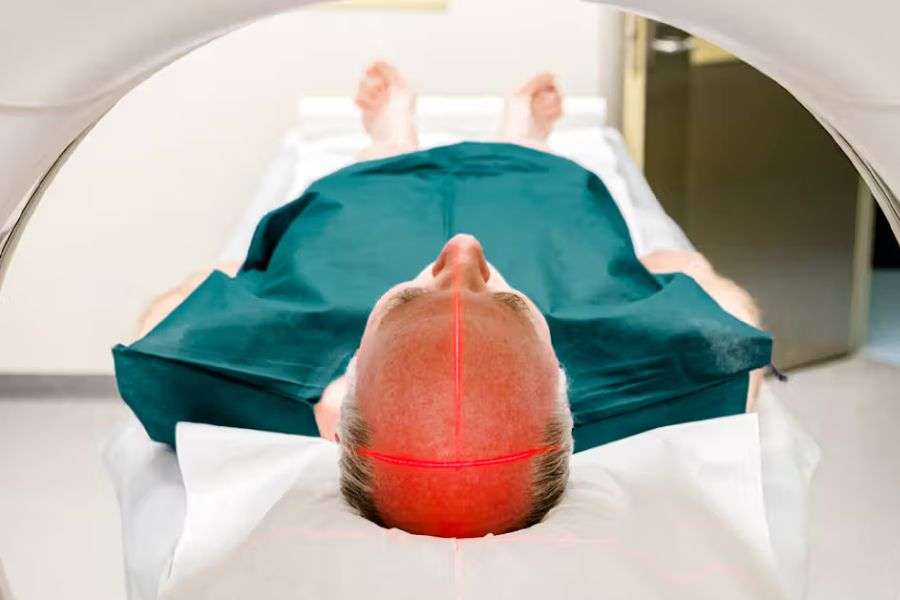Central Pontine Myelinolysis
Overview

Central pontine myelinolysis (CPM) is a medical condition that affects the myelin and nerve cells located in the middle part of the brainstem called the pons.
The brainstem functions as a messenger between the spinal cord and the thinking part of the brain, and it is also responsible for controlling vital functions such as breathing, digestion, and heart rate.
CPM can cause damage to the myelin sheath, resulting in symptoms such as difficulty speaking, swallowing, and walking, among others. Another name for CPM is osmotic demyelination syndrome.
It is essential to seek medical attention if you experience any of these symptoms to receive proper treatment.
Symptoms
• Symptoms of CPM typically emerge days post-rapid sodium level correction, contingent on brain myelination site and extent of damage.
• Manifestations may entail behavioral shifts, confusion, and difficulties in speech and swallowing.
• Facial paralysis, muscle weakness, and impaired balance and coordination are common indicators.
• Involuntary muscle movements, tremors, and irregular eye motions, termed oculomotor dysfunction, may also arise.
• Some may experience Parkinsonism-like symptoms akin to Parkinson's disease, including tremors and speech impairments.
• Recognizing these symptoms is pivotal for timely diagnosis and intervention to mitigate potential complications.
Causes & Risks
• Central pontine myelinolysis (CPM) primarily arises from a swift surge in sodium levels, often occurring during hyponatremia correction.
• Hyponatremia, characterized by low sodium levels, can stem from various factors like excessive alcohol intake, liver disease, or other health issues.
• Left untreated, hyponatremia can precipitate severe complications, necessitating hospitalization for corrective measures.
• Healthcare providers typically administer intravenous sodium solutions to rectify low sodium levels, but a rapid increase can trigger CPM.
• Any condition inducing prolonged hyponatremia elevates the risk of CPM, particularly if sodium levels remain low for over 48 hours.
• Awareness of these risk factors is crucial for healthcare providers to implement appropriate preventive measures during hyponatremia management.
Test & Diagnosis
• Healthcare providers diagnose CPM by:
1. Inquiring about symptoms and potential causes, including past sodium levels during treatment.
2. Conducting an MRI scan.
• MRI scans reveal lesions resulting from myelinolysis, which may not be immediately visible and could take up to two weeks post-symptom onset to detect.
• The combination of symptom assessment, medical history review, and MRI findings enables accurate diagnosis and treatment planning.
• Timely diagnosis is critical for initiating appropriate interventions and optimizing patient outcomes.
Treatment
• Treatment for CPM varies and focuses on symptom management rather than a standardized approach.
• Dopaminergic drugs, which increase dopamine levels, may alleviate symptoms akin to Parkinson's disease, like tremors or speech issues.
• Some cases involve gradually lowering and slowly raising sodium levels, although this approach may not work for everyone.
• The effectiveness of treatments can vary among individuals, highlighting the need for personalized care.
• Healthcare providers tailor treatment plans based on the severity of symptoms and the patient's response to therapy.
• Close monitoring and adjustments to treatment are crucial for optimizing outcomes in CPM management.
Living With
The prognosis for those with Central Pontine Myelinolysis (CPM) hinges on the severity of the condition and neurological impairment.
Mild cases may exhibit gradual improvement with supportive care and rehabilitation efforts.
Conversely, severe instances may lead to enduring disabilities, necessitating continuous therapy, and aid in daily tasks. Recovery often unfolds slowly and unpredictably, with some individuals facing persistent neurological deficits despite intervention.
Due to the variable nature of the condition, prognosis may differ significantly among affected individuals.
Therefore, personalized care and ongoing support are crucial to optimizing outcomes and enhancing the quality of life for those impacted by CPM.
Complications
• Severe neurological deficits may ensue, encompassing muscle weakness, paralysis, and impaired speech, swallowing, and coordination.
• Permanent disability may occur in severe instances, affecting mobility and daily activities.
• Cognitive issues, memory problems, and alterations in behavior or personality may arise as complications.
• Breathing challenges and other life-threatening issues can manifest during critical phases of the condition.
• These complications significantly impact the quality of life and functional abilities of individuals with CPM.
• Management and intervention strategies aim to mitigate these complications and improve overall outcomes for affected individuals.

The Content is not intended to be a substitute for professional medical advice, diagnosis, or treatment. Always seek the advice of your physician or other qualified health provider with any questions you may have regarding a medical condition.
Know more about
Our Healthcare Planner
Personal Health Planner at BNC is a support staff who listens to your concerns and connects you with a Neuro Care provider. They prioritize your needs and create a trusting relationship between you and the provider.
Three fundamental values we can assure you:
1. Personalized Healthcare.
2. Most advanced robotic therapies
3. Transparent pricing





